Report: “Yokai” parade in Kamakura~”Menkake procession”


https://www.jalan.net/rentacar/drive/140000/5967/
Date: 18, September every year
Location: Sakanoshita 4-9, Kamakura city, Kanagawa prefecture (Goryo shrine)
Access: From Kamakura station, take Enoshima line (Enoden) to Hase station and take a five-minutes walk. Kamakura is about 1 hour from Tokyo by JR line.
There are many “Yokai” in Japan.
In Japan, there are things called “Yokai”. Many people often translate it as “spirits”. This is not a mistake. However, since Japan is basically a polytheistic country, people sometimes perceive the deities as “spirits” as well. So what is a “yokai”? If you look at the letters (if you know “Kanji”), it means “something strange” or “something suspicious”. This given name is relatively new, and people originally called them “oni (ogre)”. The word “oni” comes from the old word “onu,” which means “hidden thing”. The people believed that there was another world besides the one they lived in, and that those who lived in that world sometimes appeared in front of the people (for example, at night). They also believed that wars and droughts were all their doings. Otherwise, people could not cope with the absurdity of everyday life. In addition, the idea that objects become monsters after a hundred years of use arose, and the variety increased even more. Already around the 7th century, paintings of oni were drawn. As the spread of Buddhism progressed, paintings of ogres began to appear more frequently to teach the lesson that people who did not believe in Buddhism would go to hell.




However, it was during the Edo period (17th C~early half of 19th C) that “yokai” were most developed. In this period, people enjoyed various kinds of yokai as objects of entertainment and also used them as tools to criticize the government. This is how “yokai” continues to be used today. People say that when they feel insecure about the times, a “yokai” boom occurs.


This is how Japanese people have come to know yokai. In the Heian period (794-1185), people often met a procession of yokai at night.
There is an event in Kamakura that is evoking the procession of yokai. That is the “Menkake Procession 面掛行列”.

The place is Goryo 御霊 Shrine in Kamakura. Kamakura is one of the leading tourist destinations, known as one of the three ancient capitals of Japan. Among the many shrines and temples, few people usually visited this shrine, and it is a quiet place that seems to have been forgotten. But not every September 18. The area around the shrine is closed to traffic, and many people line the streets. The reason is to see the strange procession.
Origin of the parade



The reason why this day is in September is because it is said to be the anniversary of the death of Kamakura Gongoro, the god enshrined in this shrine. Gongoro was a warlord who was active in the 11th century, and was known for his bravery and courage. In Kabuki, he appears as hero. But the procession has nothing to do with Gongoro. There is a record that the procession was originally held at Hachiman Shrine, the center of Kamakura. According to the legend, Yoritomo, the founder of the Kamakura Shogunate, got a woman other than his wife pregnant. Some say that the family joined the procession to protect Yoritomo, while others say that they were allowed to join the procession on this day only without formalities. In any case, this family was of low status, so they wore masks to hide their faces. However, because these are just legends, no one knows exactly what the truth is.
Going to see


Kamakura is a small town. It is possible to walk from Kamakura station to the shrine, as it is only about 2 km. The surrounding area is lined with Zen temples, and the ocean is located nearby. If you want to take the train, transfer from JR Kamakura Station to the Enoden 江ノ電 train right next door, which takes about 5 minutes. Get off at Hase 長谷 Station. On weekends and holidays, it is as crowded as Shinjuku Station, the busiest station in Japan, but since Hase Station is the closest to the great Buddha (Daibutsu), many people get off the train, so don’t worry. The procession departs from the shrine and goes back and forth along “Hoshi-noi-dori 星の井通り” just in front of it. It’s a modest distance, so it’s easy to find a spot without rushing.
Procession




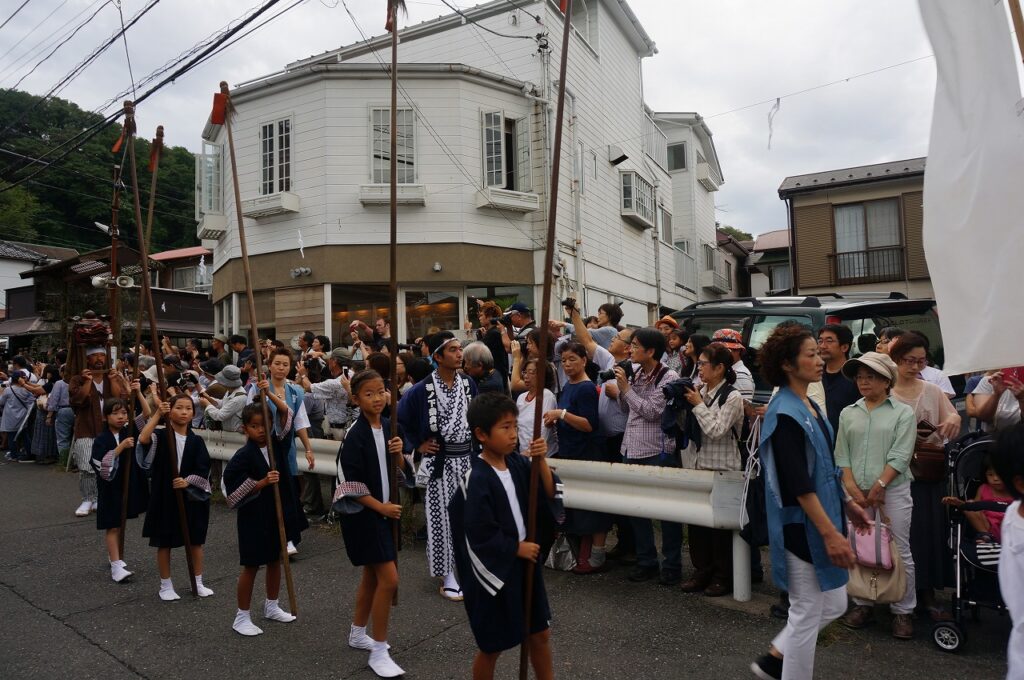
When it was time to go, the sound of flutes and drums would be able to reach us. Finally, the procession begins. The masks don’t come instantly. Things that you can’t really understand unless you ask them about their origins are coming one after the other. The person leading the way looked like an Edo-period official. The people are carrying the portable shrine (mikoshi) quietly without any vigorous shouting. The musical accompaniment was also somewhat elegant. Children walked in with what looked like red streamers attached to the end of long sticks. People are wearing kimonos and hakama (Both are ancient Japanese folk costumes). The scenery is reminiscent of the illusion of an old samurai procession. Of course, no one has ever seen the real thing, but there are many reenactments of daimyo processions at festivals around the country.



In the meantime, the tengu-faced Sarutahiko (*1) finally arrives. It is a common sight to see him leading a festival procession, since legend has it that he led the way at the time of Ninigi’s descent in mythology(*2). In his tall geta (Japanese wooden clogs) and long ”Shakujo (monks staff made from metal) attire, he walks leisurely with a sound ting-a-ling.
*1 https://discoverdeeperjapan.com/2020/06/07/the-most-detailed-japanese-traditional-mask/
*2 https://discoverdeeperjapan.com/reference/japan-mychology-and-history/
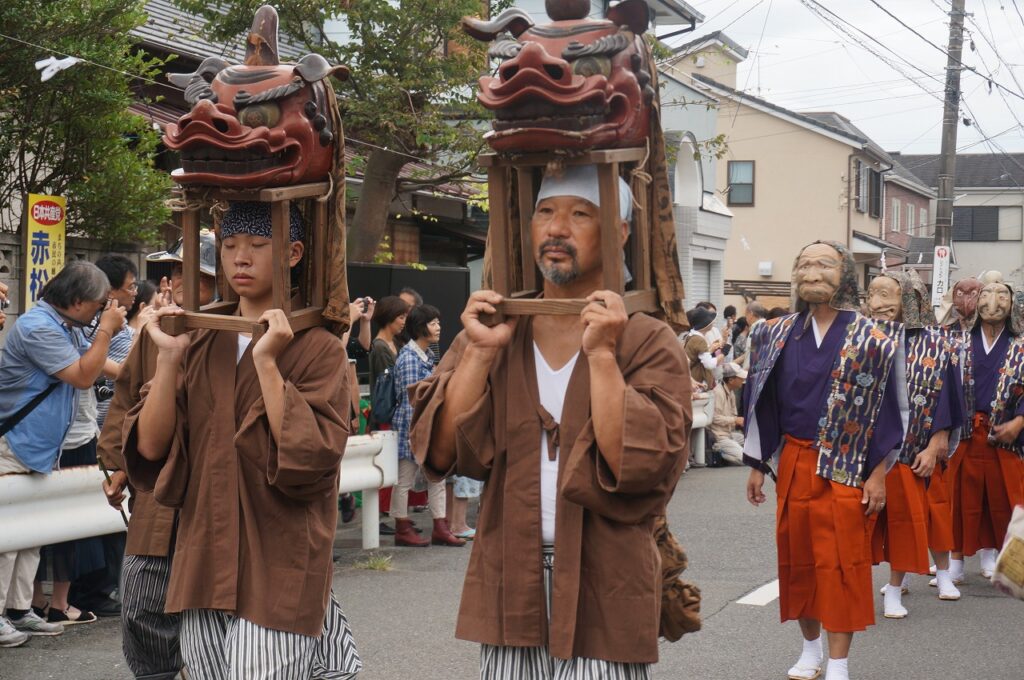

The lion comes next, but instead of wearing a mask like a normal lion, it is placed on top of the head. It’s a little different in every way. Finally, in the middle of the procession, a group of oddly shaped people wearing the masks we were looking for arrived. The excitement of the people is at its peak. Dressed in matching outfits, the “yokai” parade through the streets in broad daylight. Ten in all. Each of them is as unique as the other members of the group. They paraded through the streets without looking at anyone in the eye at all.
Masks



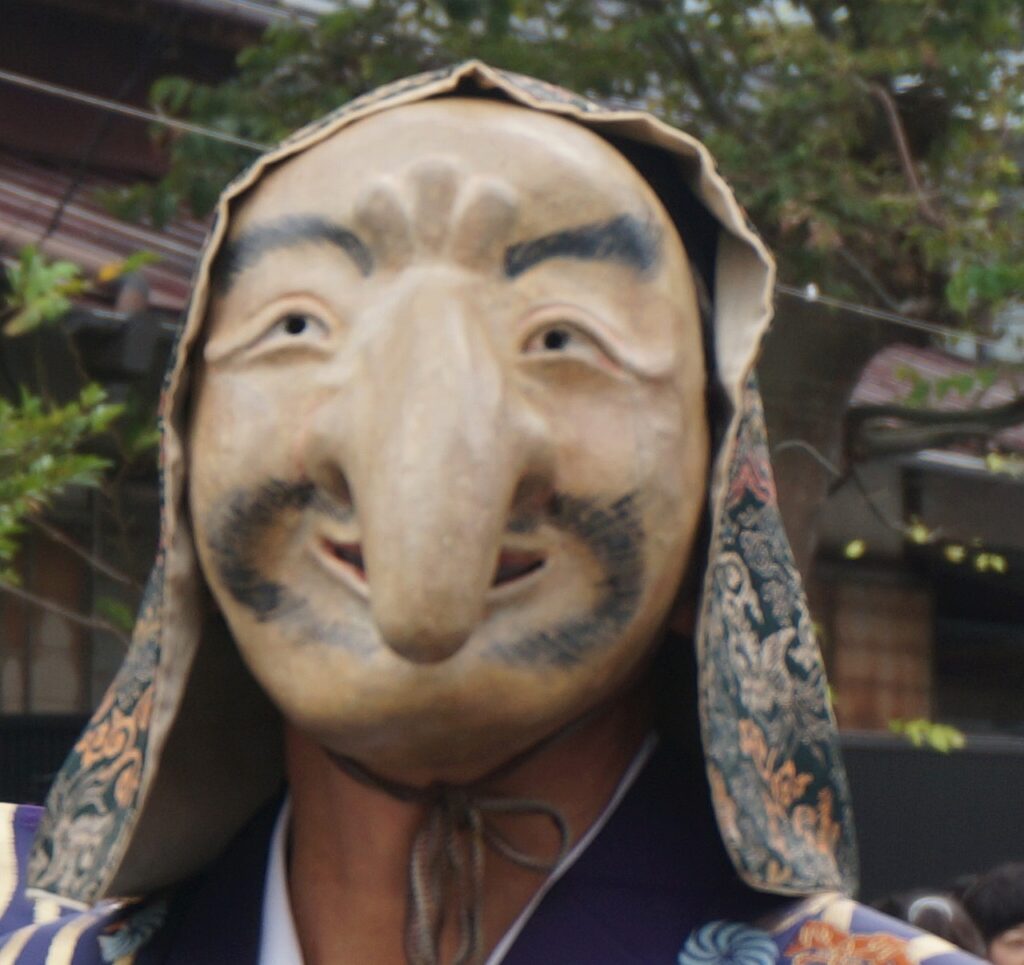






From the top to the bottom, there’s “Jijii 爺 (old man),”Oni 鬼 (ogre)”, “Igyo 異形 (variant)”, “Hananaga 鼻長 (long nose)”, “Karasu tengu 烏天狗 (crow billed Tengu)”, “Okina 翁 (aged man)”, “Hifuki-otoko 火吹き男 (fire breathing man), “Fukuroku 福禄 (prosperity and long life)” and “Toriage 取り上げ (midwife)”, “Okame おかめ (woman)” who is the main characters of the day.

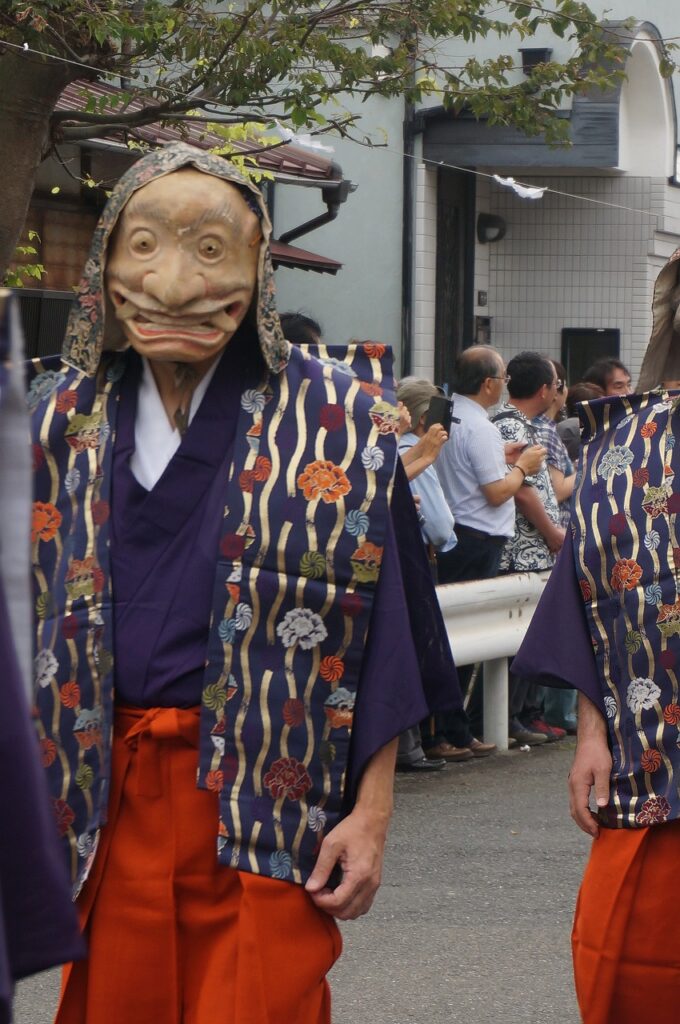
Why these masks were chosen is a mystery. Still, it is a strange sight to see again and again. The specters walked the streets as if they owned the place, while the humans played a supporting role. They pass by in silence. However, when I look at them like this, I feel as if I can hear their voices.

Karasu-tengu: It was usually quiet as I walked at night, but there were a lot of people walking around during the day.
Hananaga: You are so loud. Quiet down and walk.

Okina: Thank you all for your hard work standing in line. It’s a pleasure to meet you all.

Hifuki-otoko: Hmm. Are we really that rare? Say hello to me, too.

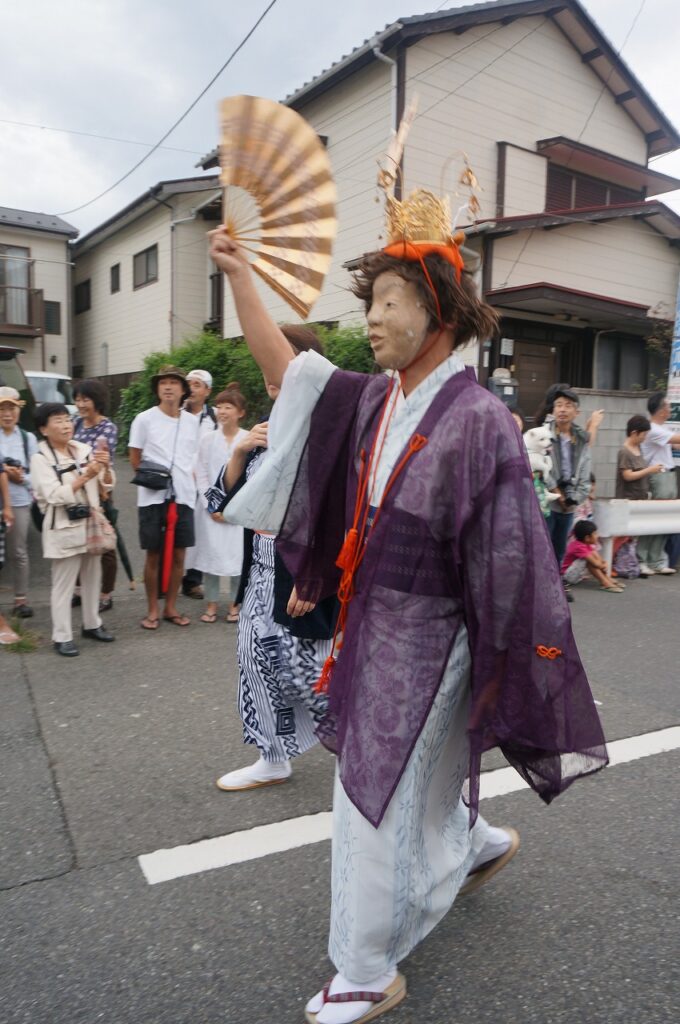
Toriage: Hey, wait a minute. You’re a little quick for a pregnant lady, aren’t you?
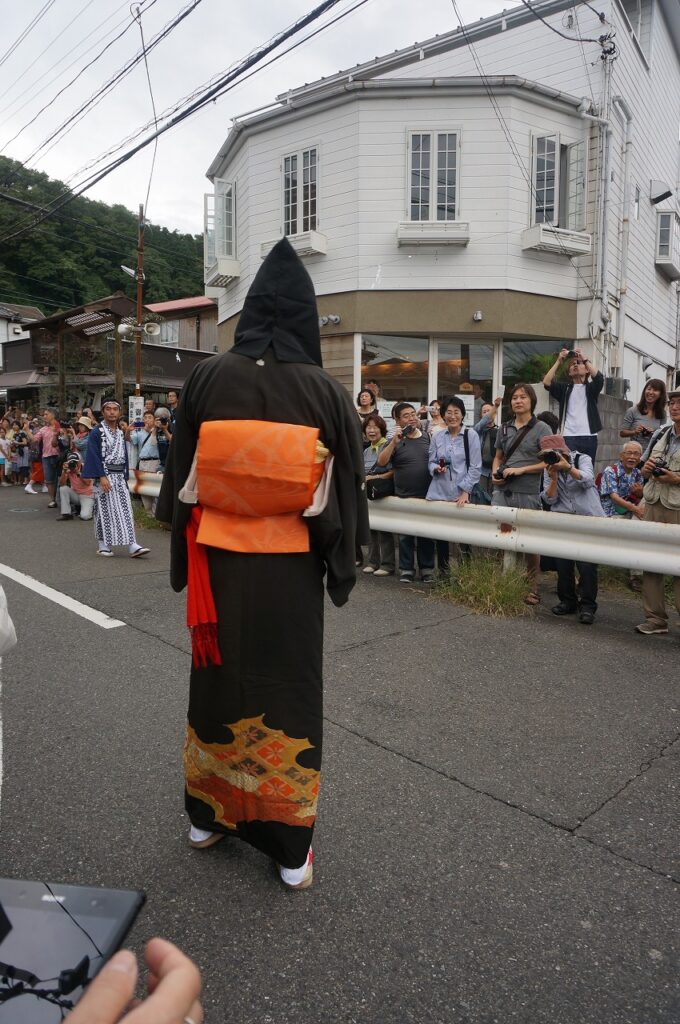
Okame: I’ll keep waiting without your telling me. I’m a star, people won’t let me go.

Fukuroku: Hey, what? You’re ignoring me?



They go to Hoshinoi Street and come back again. But the madness doesn’t last long. People don’t allow them to occupy the town all day long. After about 20 minutes, they return to the shrine. People follow them, trying to bask in as much of the afterglow as possible.



The portable shrine is quickly dismantled and the oddly-looking group disappears. They were kind enough to put their masks back on and take pictures with us. But that was only for a short time. The lion’s head returns to its original position, and daily life returns.




The masks are in the collection of the Gallery of Treasures, so you can see them if you wish. But, they are just quiet and silent.


Reference: https://youkosonihon.com/2018/03/17/menkake-gyouretsu-menkake-parade-kamakura/
Contact information: http://www.city.kamakura.kanagawa.jp/visitkamakura/en/